A Research Report on Student Food Choices and Costs on Campus
VerifiedAdded on 2020/04/15
|7
|1302
|29
Report
AI Summary
This research report investigates student food consumption patterns on a university campus. The study utilizes questionnaires to gather data from undergraduate and postgraduate students, exploring the cost of meals, student satisfaction with on-campus versus off-campus food, and the variety of food options available. Findings reveal that cost is a significant factor influencing students' preference for off-campus food, while convenience drives on-campus consumption. The report highlights student perceptions of food expenses, variety, and overall satisfaction levels. The research concludes with recommendations for university catering departments to address cost concerns and improve student dining experiences. The report provides valuable insights into the factors shaping student food choices and offers a foundation for enhancing campus food services.
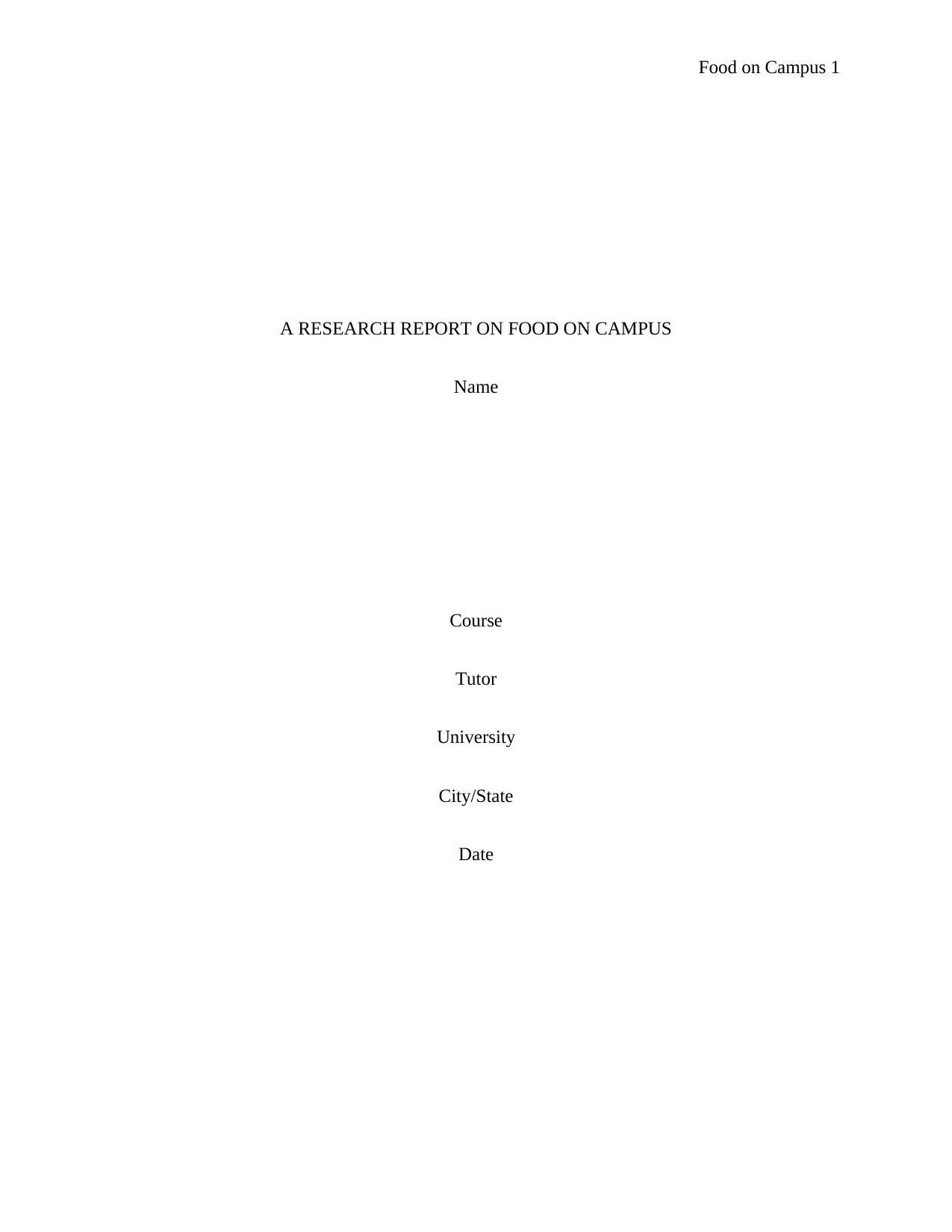
Food on Campus 1
A RESEARCH REPORT ON FOOD ON CAMPUS
Name
Course
Tutor
University
City/State
Date
A RESEARCH REPORT ON FOOD ON CAMPUS
Name
Course
Tutor
University
City/State
Date
Paraphrase This Document
Need a fresh take? Get an instant paraphrase of this document with our AI Paraphraser
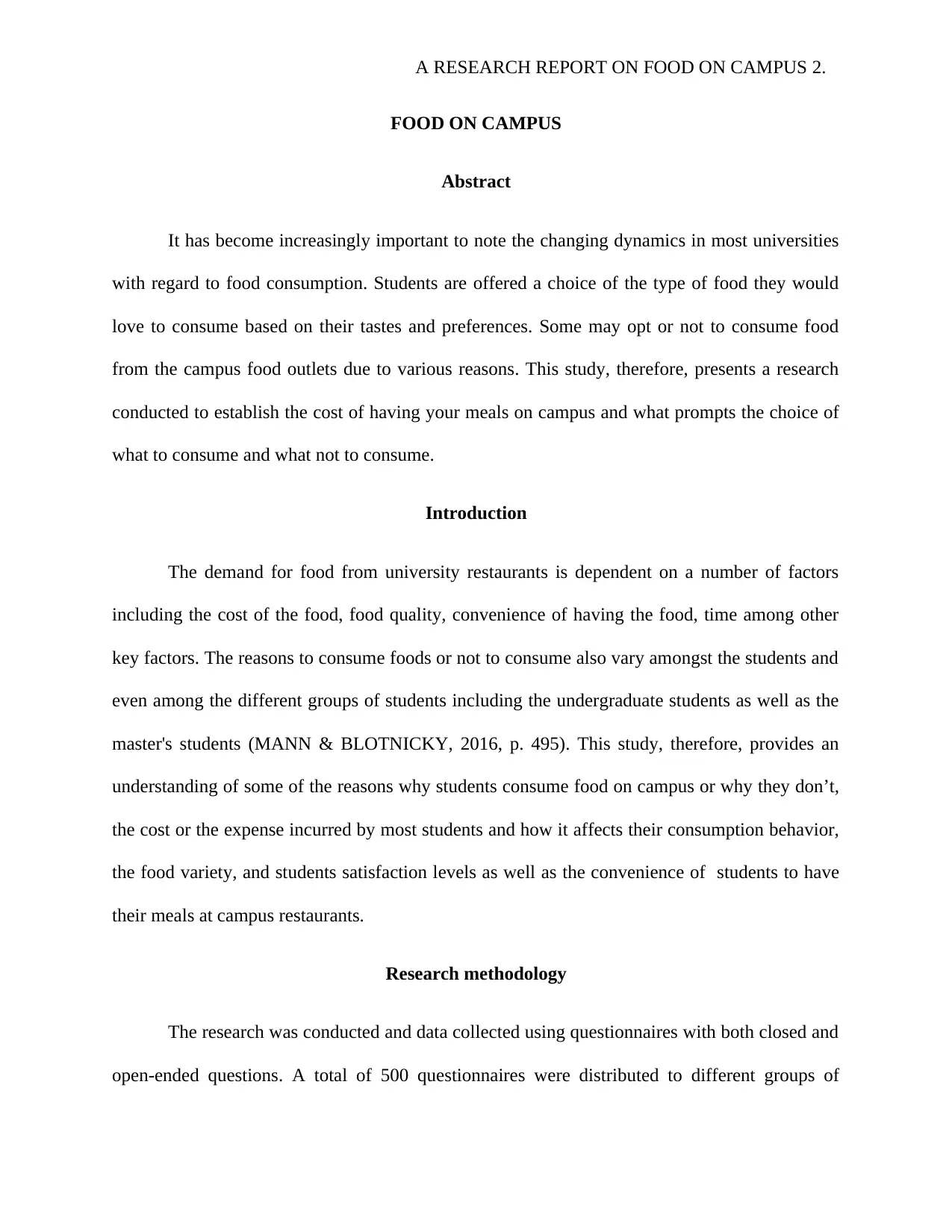
A RESEARCH REPORT ON FOOD ON CAMPUS 2.
FOOD ON CAMPUS
Abstract
It has become increasingly important to note the changing dynamics in most universities
with regard to food consumption. Students are offered a choice of the type of food they would
love to consume based on their tastes and preferences. Some may opt or not to consume food
from the campus food outlets due to various reasons. This study, therefore, presents a research
conducted to establish the cost of having your meals on campus and what prompts the choice of
what to consume and what not to consume.
Introduction
The demand for food from university restaurants is dependent on a number of factors
including the cost of the food, food quality, convenience of having the food, time among other
key factors. The reasons to consume foods or not to consume also vary amongst the students and
even among the different groups of students including the undergraduate students as well as the
master's students (MANN & BLOTNICKY, 2016, p. 495). This study, therefore, provides an
understanding of some of the reasons why students consume food on campus or why they don’t,
the cost or the expense incurred by most students and how it affects their consumption behavior,
the food variety, and students satisfaction levels as well as the convenience of students to have
their meals at campus restaurants.
Research methodology
The research was conducted and data collected using questionnaires with both closed and
open-ended questions. A total of 500 questionnaires were distributed to different groups of
FOOD ON CAMPUS
Abstract
It has become increasingly important to note the changing dynamics in most universities
with regard to food consumption. Students are offered a choice of the type of food they would
love to consume based on their tastes and preferences. Some may opt or not to consume food
from the campus food outlets due to various reasons. This study, therefore, presents a research
conducted to establish the cost of having your meals on campus and what prompts the choice of
what to consume and what not to consume.
Introduction
The demand for food from university restaurants is dependent on a number of factors
including the cost of the food, food quality, convenience of having the food, time among other
key factors. The reasons to consume foods or not to consume also vary amongst the students and
even among the different groups of students including the undergraduate students as well as the
master's students (MANN & BLOTNICKY, 2016, p. 495). This study, therefore, provides an
understanding of some of the reasons why students consume food on campus or why they don’t,
the cost or the expense incurred by most students and how it affects their consumption behavior,
the food variety, and students satisfaction levels as well as the convenience of students to have
their meals at campus restaurants.
Research methodology
The research was conducted and data collected using questionnaires with both closed and
open-ended questions. A total of 500 questionnaires were distributed to different groups of
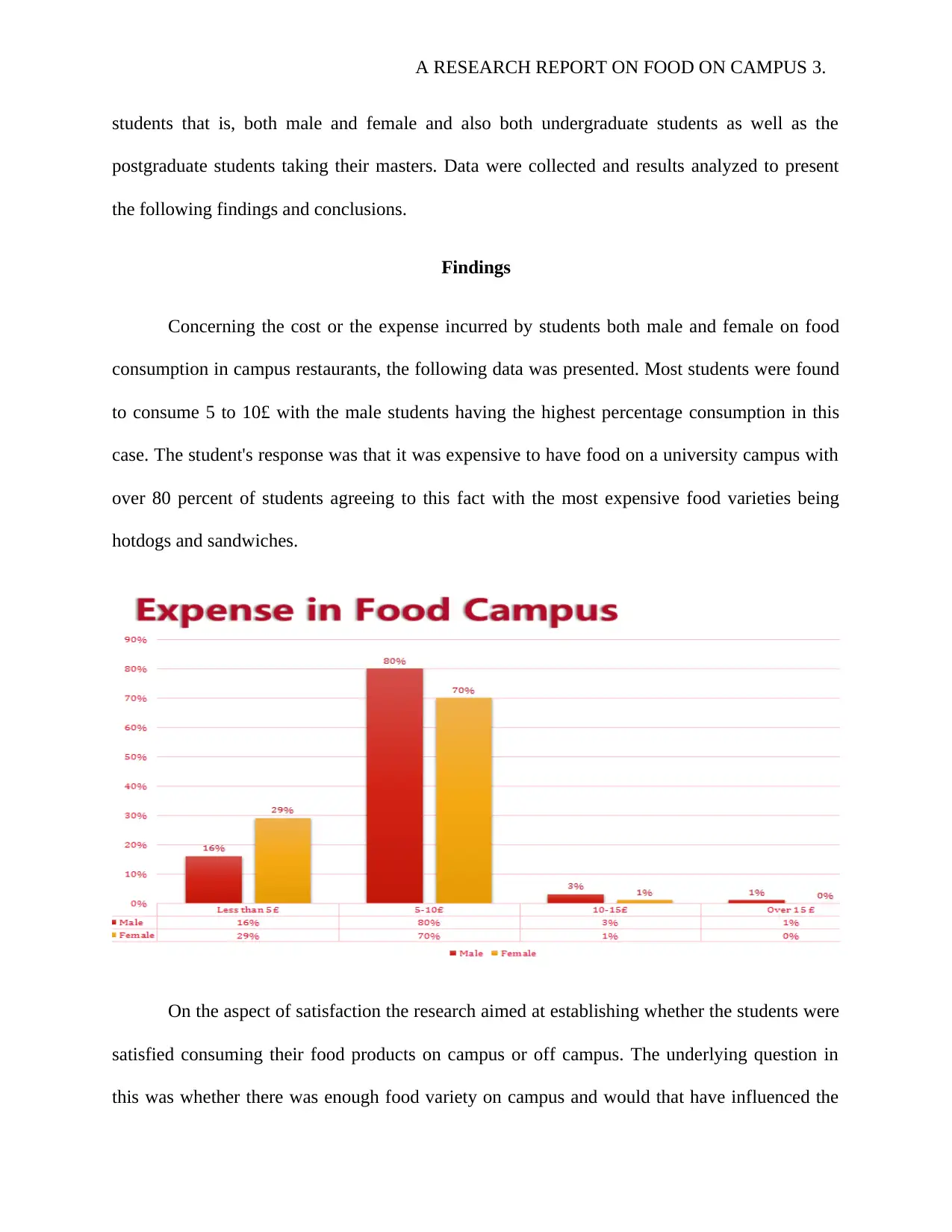
A RESEARCH REPORT ON FOOD ON CAMPUS 3.
students that is, both male and female and also both undergraduate students as well as the
postgraduate students taking their masters. Data were collected and results analyzed to present
the following findings and conclusions.
Findings
Concerning the cost or the expense incurred by students both male and female on food
consumption in campus restaurants, the following data was presented. Most students were found
to consume 5 to 10£ with the male students having the highest percentage consumption in this
case. The student's response was that it was expensive to have food on a university campus with
over 80 percent of students agreeing to this fact with the most expensive food varieties being
hotdogs and sandwiches.
On the aspect of satisfaction the research aimed at establishing whether the students were
satisfied consuming their food products on campus or off campus. The underlying question in
this was whether there was enough food variety on campus and would that have influenced the
students that is, both male and female and also both undergraduate students as well as the
postgraduate students taking their masters. Data were collected and results analyzed to present
the following findings and conclusions.
Findings
Concerning the cost or the expense incurred by students both male and female on food
consumption in campus restaurants, the following data was presented. Most students were found
to consume 5 to 10£ with the male students having the highest percentage consumption in this
case. The student's response was that it was expensive to have food on a university campus with
over 80 percent of students agreeing to this fact with the most expensive food varieties being
hotdogs and sandwiches.
On the aspect of satisfaction the research aimed at establishing whether the students were
satisfied consuming their food products on campus or off campus. The underlying question in
this was whether there was enough food variety on campus and would that have influenced the
⊘ This is a preview!⊘
Do you want full access?
Subscribe today to unlock all pages.

Trusted by 1+ million students worldwide
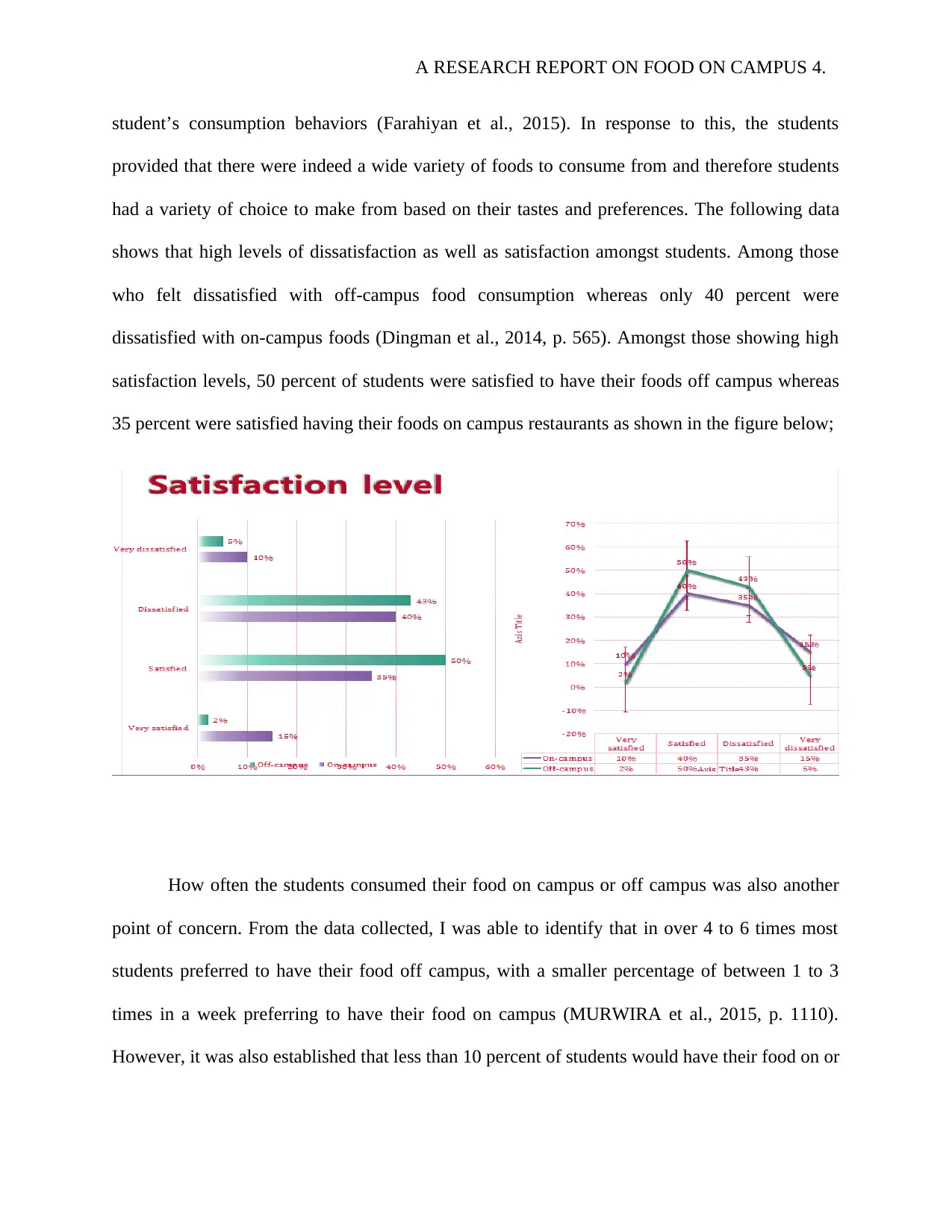
A RESEARCH REPORT ON FOOD ON CAMPUS 4.
student’s consumption behaviors (Farahiyan et al., 2015). In response to this, the students
provided that there were indeed a wide variety of foods to consume from and therefore students
had a variety of choice to make from based on their tastes and preferences. The following data
shows that high levels of dissatisfaction as well as satisfaction amongst students. Among those
who felt dissatisfied with off-campus food consumption whereas only 40 percent were
dissatisfied with on-campus foods (Dingman et al., 2014, p. 565). Amongst those showing high
satisfaction levels, 50 percent of students were satisfied to have their foods off campus whereas
35 percent were satisfied having their foods on campus restaurants as shown in the figure below;
How often the students consumed their food on campus or off campus was also another
point of concern. From the data collected, I was able to identify that in over 4 to 6 times most
students preferred to have their food off campus, with a smaller percentage of between 1 to 3
times in a week preferring to have their food on campus (MURWIRA et al., 2015, p. 1110).
However, it was also established that less than 10 percent of students would have their food on or
student’s consumption behaviors (Farahiyan et al., 2015). In response to this, the students
provided that there were indeed a wide variety of foods to consume from and therefore students
had a variety of choice to make from based on their tastes and preferences. The following data
shows that high levels of dissatisfaction as well as satisfaction amongst students. Among those
who felt dissatisfied with off-campus food consumption whereas only 40 percent were
dissatisfied with on-campus foods (Dingman et al., 2014, p. 565). Amongst those showing high
satisfaction levels, 50 percent of students were satisfied to have their foods off campus whereas
35 percent were satisfied having their foods on campus restaurants as shown in the figure below;
How often the students consumed their food on campus or off campus was also another
point of concern. From the data collected, I was able to identify that in over 4 to 6 times most
students preferred to have their food off campus, with a smaller percentage of between 1 to 3
times in a week preferring to have their food on campus (MURWIRA et al., 2015, p. 1110).
However, it was also established that less than 10 percent of students would have their food on or
Paraphrase This Document
Need a fresh take? Get an instant paraphrase of this document with our AI Paraphraser
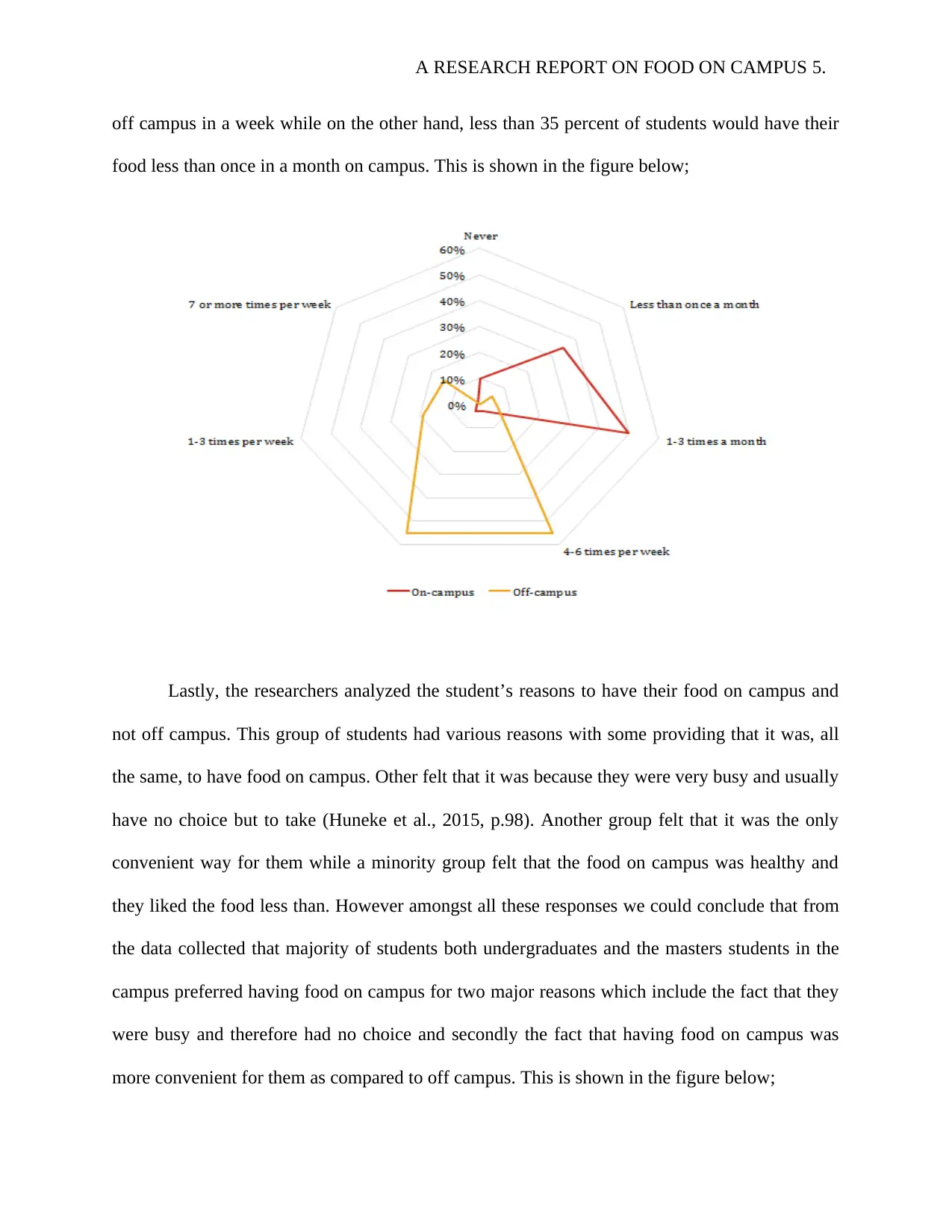
A RESEARCH REPORT ON FOOD ON CAMPUS 5.
off campus in a week while on the other hand, less than 35 percent of students would have their
food less than once in a month on campus. This is shown in the figure below;
Lastly, the researchers analyzed the student’s reasons to have their food on campus and
not off campus. This group of students had various reasons with some providing that it was, all
the same, to have food on campus. Other felt that it was because they were very busy and usually
have no choice but to take (Huneke et al., 2015, p.98). Another group felt that it was the only
convenient way for them while a minority group felt that the food on campus was healthy and
they liked the food less than. However amongst all these responses we could conclude that from
the data collected that majority of students both undergraduates and the masters students in the
campus preferred having food on campus for two major reasons which include the fact that they
were busy and therefore had no choice and secondly the fact that having food on campus was
more convenient for them as compared to off campus. This is shown in the figure below;
off campus in a week while on the other hand, less than 35 percent of students would have their
food less than once in a month on campus. This is shown in the figure below;
Lastly, the researchers analyzed the student’s reasons to have their food on campus and
not off campus. This group of students had various reasons with some providing that it was, all
the same, to have food on campus. Other felt that it was because they were very busy and usually
have no choice but to take (Huneke et al., 2015, p.98). Another group felt that it was the only
convenient way for them while a minority group felt that the food on campus was healthy and
they liked the food less than. However amongst all these responses we could conclude that from
the data collected that majority of students both undergraduates and the masters students in the
campus preferred having food on campus for two major reasons which include the fact that they
were busy and therefore had no choice and secondly the fact that having food on campus was
more convenient for them as compared to off campus. This is shown in the figure below;
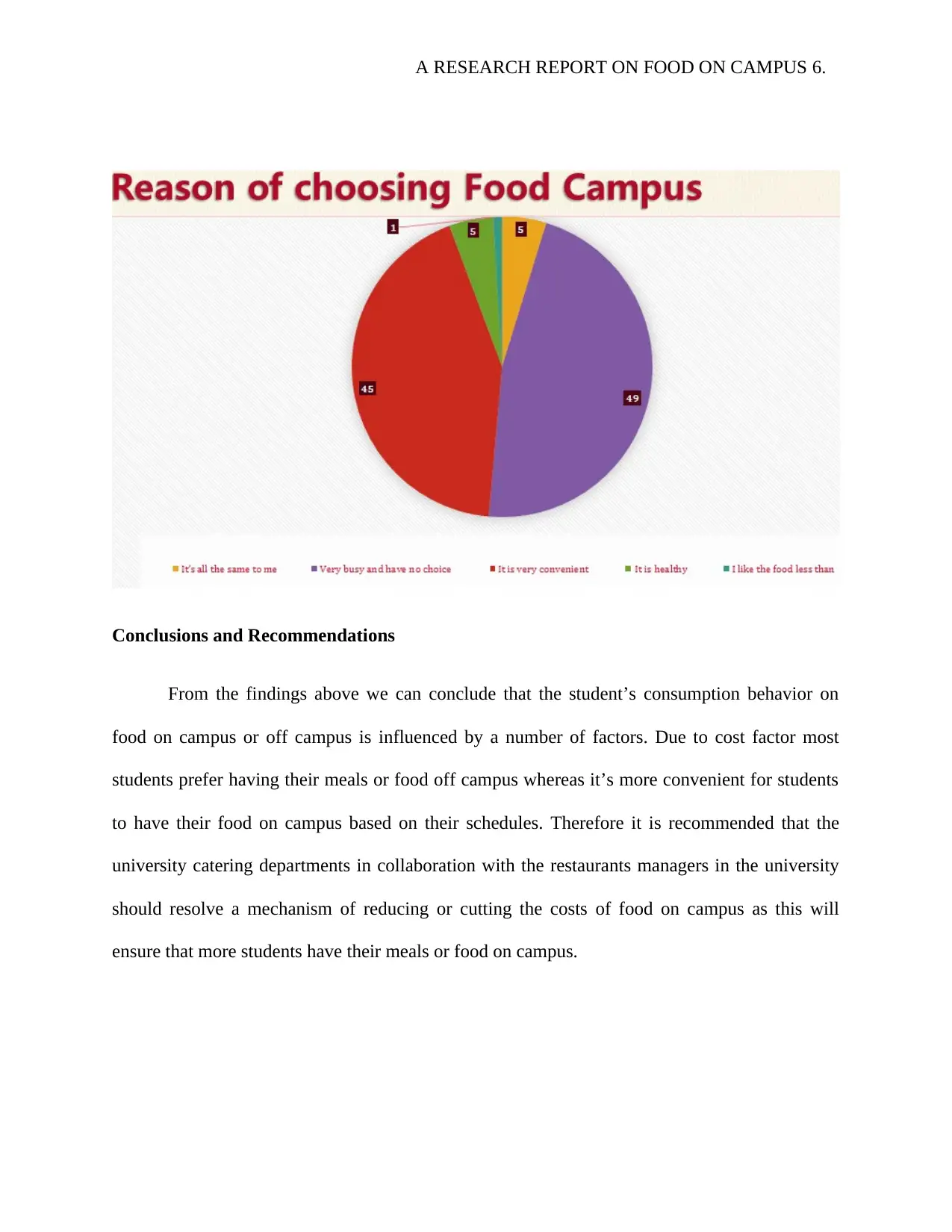
A RESEARCH REPORT ON FOOD ON CAMPUS 6.
Conclusions and Recommendations
From the findings above we can conclude that the student’s consumption behavior on
food on campus or off campus is influenced by a number of factors. Due to cost factor most
students prefer having their meals or food off campus whereas it’s more convenient for students
to have their food on campus based on their schedules. Therefore it is recommended that the
university catering departments in collaboration with the restaurants managers in the university
should resolve a mechanism of reducing or cutting the costs of food on campus as this will
ensure that more students have their meals or food on campus.
Conclusions and Recommendations
From the findings above we can conclude that the student’s consumption behavior on
food on campus or off campus is influenced by a number of factors. Due to cost factor most
students prefer having their meals or food off campus whereas it’s more convenient for students
to have their food on campus based on their schedules. Therefore it is recommended that the
university catering departments in collaboration with the restaurants managers in the university
should resolve a mechanism of reducing or cutting the costs of food on campus as this will
ensure that more students have their meals or food on campus.
⊘ This is a preview!⊘
Do you want full access?
Subscribe today to unlock all pages.

Trusted by 1+ million students worldwide
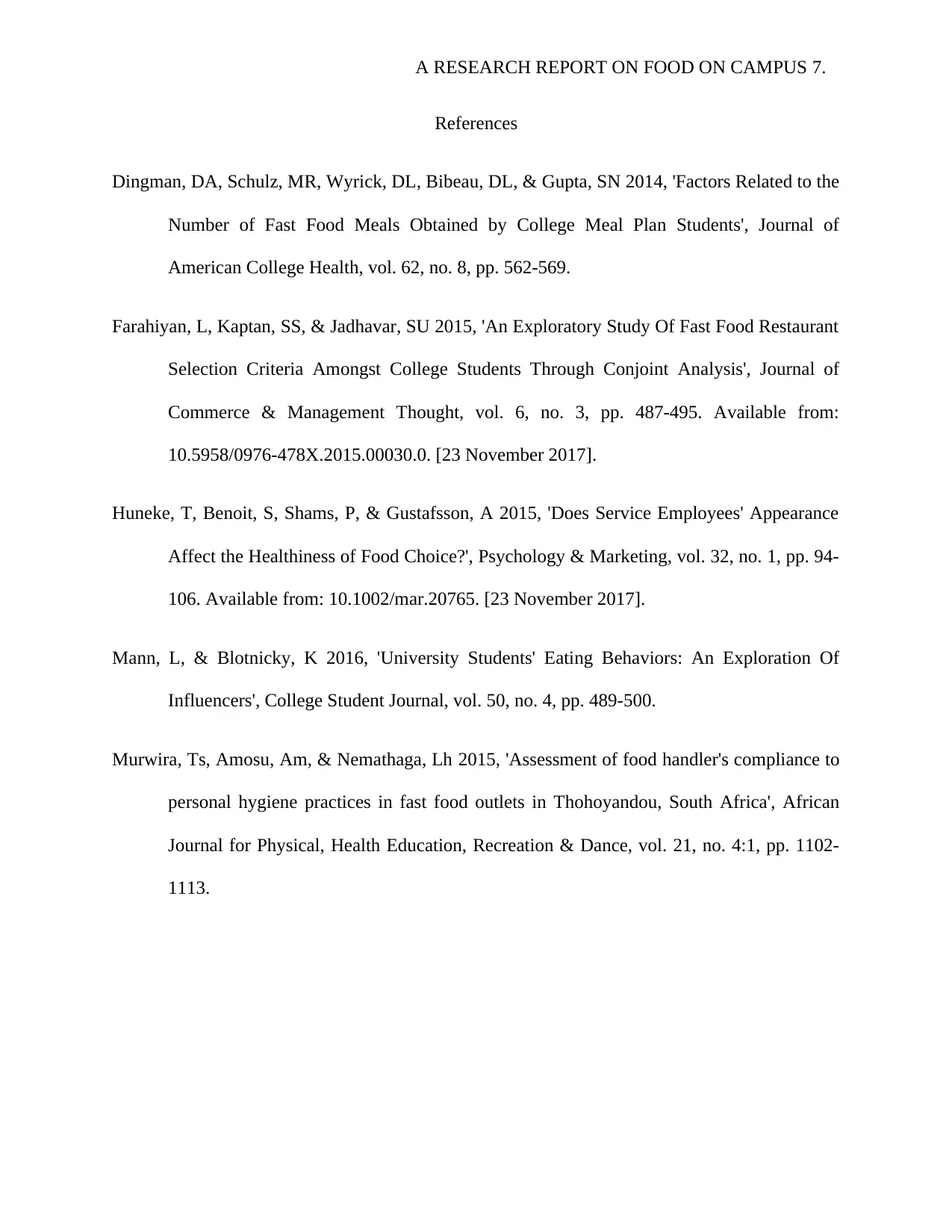
A RESEARCH REPORT ON FOOD ON CAMPUS 7.
References
Dingman, DA, Schulz, MR, Wyrick, DL, Bibeau, DL, & Gupta, SN 2014, 'Factors Related to the
Number of Fast Food Meals Obtained by College Meal Plan Students', Journal of
American College Health, vol. 62, no. 8, pp. 562-569.
Farahiyan, L, Kaptan, SS, & Jadhavar, SU 2015, 'An Exploratory Study Of Fast Food Restaurant
Selection Criteria Amongst College Students Through Conjoint Analysis', Journal of
Commerce & Management Thought, vol. 6, no. 3, pp. 487-495. Available from:
10.5958/0976-478X.2015.00030.0. [23 November 2017].
Huneke, T, Benoit, S, Shams, P, & Gustafsson, A 2015, 'Does Service Employees' Appearance
Affect the Healthiness of Food Choice?', Psychology & Marketing, vol. 32, no. 1, pp. 94-
106. Available from: 10.1002/mar.20765. [23 November 2017].
Mann, L, & Blotnicky, K 2016, 'University Students' Eating Behaviors: An Exploration Of
Influencers', College Student Journal, vol. 50, no. 4, pp. 489-500.
Murwira, Ts, Amosu, Am, & Nemathaga, Lh 2015, 'Assessment of food handler's compliance to
personal hygiene practices in fast food outlets in Thohoyandou, South Africa', African
Journal for Physical, Health Education, Recreation & Dance, vol. 21, no. 4:1, pp. 1102-
1113.
References
Dingman, DA, Schulz, MR, Wyrick, DL, Bibeau, DL, & Gupta, SN 2014, 'Factors Related to the
Number of Fast Food Meals Obtained by College Meal Plan Students', Journal of
American College Health, vol. 62, no. 8, pp. 562-569.
Farahiyan, L, Kaptan, SS, & Jadhavar, SU 2015, 'An Exploratory Study Of Fast Food Restaurant
Selection Criteria Amongst College Students Through Conjoint Analysis', Journal of
Commerce & Management Thought, vol. 6, no. 3, pp. 487-495. Available from:
10.5958/0976-478X.2015.00030.0. [23 November 2017].
Huneke, T, Benoit, S, Shams, P, & Gustafsson, A 2015, 'Does Service Employees' Appearance
Affect the Healthiness of Food Choice?', Psychology & Marketing, vol. 32, no. 1, pp. 94-
106. Available from: 10.1002/mar.20765. [23 November 2017].
Mann, L, & Blotnicky, K 2016, 'University Students' Eating Behaviors: An Exploration Of
Influencers', College Student Journal, vol. 50, no. 4, pp. 489-500.
Murwira, Ts, Amosu, Am, & Nemathaga, Lh 2015, 'Assessment of food handler's compliance to
personal hygiene practices in fast food outlets in Thohoyandou, South Africa', African
Journal for Physical, Health Education, Recreation & Dance, vol. 21, no. 4:1, pp. 1102-
1113.
1 out of 7
Related Documents
Your All-in-One AI-Powered Toolkit for Academic Success.
+13062052269
info@desklib.com
Available 24*7 on WhatsApp / Email
![[object Object]](/_next/static/media/star-bottom.7253800d.svg)
Unlock your academic potential
Copyright © 2020–2025 A2Z Services. All Rights Reserved. Developed and managed by ZUCOL.





